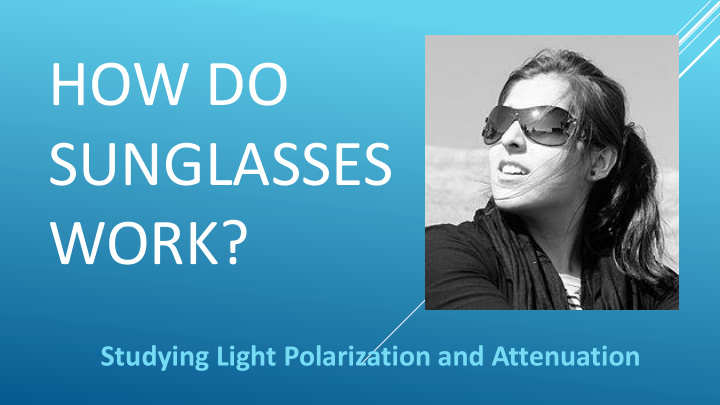



HOW DO SUNGLASSES WORK? Studying Light Polarization and Attenuation
What Do Sunglasses Do? Brainstorm in your groups: What are the key objectives of good sunglasses? To reduce the glare such as reflections from the road, water, glass, snow To reduce the light intensity To block ultraviolet (UV) light and prevent eye damage
Light Polarization By the end of this lesson, you will be able to: Explain light polarization Describe methods to polarize light Explain light and electromagnetic wave attenuation
Electromagnetic Wave Structure Q: What is the cause of electromagnetic radiation? Electromagnetic waves are caused by vibrating electric charges. Q: What are the two distinct waves of electromagnetic waves? Are they transverse or longitudinal? Electromagnetic waves have 2 components: electric and magnetic This means that each EM wave (light included) has 2 distinct transverse waves -1 from the vibration of the electric field -1 due to the vibration of the magnetic field
Light Characteristics & Polarization Since light is an electromagnetic wave, it shares the same characteristics. What are these light properties? • Travels at 3.0 x 10 8 m/s • Travels in straight lines • Has more than one disturbance Since light (and all electromagnetic waves) has more than one disturbance, it also has more than one polarization > using this fact, discuss with your group the meaning of polarization
Light Polarization Polarization refers to the direction of the vibration Since the electric charges of electromagnetic waves vibrate in multiple directions, light is unpolarized Q: What are some ways in which the light polarization can change? 1. transmission 2. reflection 3. refraction 4. scattering
Transmission “Filter” Method The polarization of light can change by passing it through polaroids Polaroids are special filters that are chemically designed to let through only a specific polarization of light As light passes through the polaroid film, it becomes polarized Describe the polarization of the light in this diagram
Polarization by Transmission Using the polaroid films, answer the following questions: Q: What happens when you look at unpolarized light through the polaroid film? Explain why you think this is. The light intensity seems to be cut in half. This is because the filter actually filters out half of the light. Q: What happens when you look at unpolarized light through 2 polaroids? Be sure they are parallel. Explain why you think this is. In this case, the light intensity does not look any different than before because the light is already polarized in that direction, so the light can still pass through. Q: Now slowly begin rotating one of the polaroids until it is perpendicular to the other. Explain what happens to the light. Why do you think this is? As the polaroid is rotated, the light intensity decreases. This is because the already polarized light is being filtered again by the second polaroid. Eventually, no light is able to pass.
Reflection Method Q: What happens when light strikes any surface? The polarization of light The surface either absorbs or reflects the light depends on the plane When light reflects off a non-metallic surface, of the surface and the such as a road or water, it changes its polarization angle of incidence
Reflection Method Not all reflected light changes the polarization. As light hits a non-metallic surface, the surface vibrations cause the polarization to change For instance, the ground is flat and lies horizontally As light strikes the ground, the horizontal wave begins to vibrate more frequently than the vertical wave, and the light becomes horizontally polarized This causes the glare we see when driving! We wear sunglasses to reduce the glare Discuss in your group: What type of polarizing filter do sunglasses use to reduce glare?
Polarizing Polarized Light?? We have an equation for light intensity when subject to different polaroids The angle between 2 polaroids is important in determining the light intensity Malus ’ law describes how the intensity changes when polarized light passes through a second polaroid
Quick Check!
Light Attenuation Q: What happens to light intensity as it passes through a polaroid film? The light intensity decreases Q: This is what we call light attenuation . What is the definition of attenuation ? The reduction of intensity or power of an electromagnetic wave All electromagnetic waves attenuate through different materials Q: Different wavelengths/frequencies attenuate differently through different materials For example, 60 GHz waves are completely blocked by humans, but 2 GHz waves attenuate only slightly when passing through our bodies
Light Attenuation Q: When designing sunglasses, which portion(s) of the electromagnetic spectrum need(s) to be attenuated? • visible light • ultraviolet light Q: Normally, a plastic lens does not attenuate these wavelengths/frequencies. What can we do to attenuate them?
2007 Hamed Saber, Wikimedia Commons CC BY-SA 2.0 https://commons.wikimedia.org/wiki/File:B%26W_girl_portrait_with_sunglasses.jpg Image Imgarcade http://imgarcade.com/sunglasses-clip-art-free.html 2016 And1mu, Wikimedia Commons CC BY-SA 4.0 Sources https://commons.wikimedia.org/wiki/File:EM-Wave.gif 2006 Bob Mellish, Wikimedia Commons CC BY-SA 1.2+ https://commons.wikimedia.org/wiki/File:Wire-grid-polarizer.svg Wikimedia Commons https://upload.wikimedia.org/wikipedia/commons/thumb/0/0b/Brewster%2 7s_angle_polarization.png/800px-Brewster%27s_angle_polarization.png Imgarcade http://imgarcade.com/sunglasses-clip-art-free.html 2013 Jonathan S Urie, Wikimedia Commons CC BY-SA 3.0 https://commons.wikimedia.org/wiki/File:BW_EM_spectrum.png
Recommend
More recommend